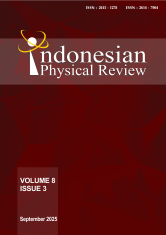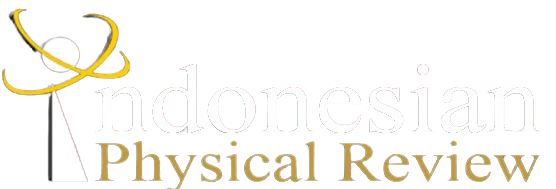PERFORMANCE OF ACTIVATED CARBON FROM WATER CHESTNUT (ELEOCHARIS DULCIS) as Fe ADSORBENT
DOI:
10.29303/ipr.v8i3.483Downloads
Abstract
This research aims to investigate the performance of activated carbon from water chestnut (WC) as an Fe adsorbent on river water samples in South Kalimantan. The WC was carbonized at a temperature of 400 °C. Then the carbon was activated with two types of activators, KOH and H2SO4 solutions. The carbonization and the activation time were also varied in two different times, 1 and 2 hours. The electrical conductivity of Martapura River water was measured to investigate its condition or quality, and yielded about 0.56  or 5600 µS/cm. It is quite large compared to the standard 1000 µS/cm. After activated carbon treatment, the electrical conductivity is reduced by about 6.67 – 13.81%. For Fe adsorption, the reduction efficiency and adsorption capacity were in the range of 7.73 % – 22.94 % and 0.50 – 1.47 mg/g. The results showed that the prepared activated carbon is effective in adsorption and decreases the Fe metal content at room temperature.Keywords:
Activated Carbon Adsorption CarbonizationReferences
Menteri Kesehatan RI, Peraturan Menteri Kesehatan Tentang Persyaratan Kualitas Air Minum. Indonesia, 2010.
E. I. Ulmi and N. Amal, “Kajian Ekohidraulik Sungai Martapura,†2015.
H. Wijayanti, H. Wahdi, and W. Nooryanto, “Utilization of Chitosan from Shrimp Shells Waste for Reduction of Iron (Fe) Metal Content in Martapura River†Konversi, vol. 9, Aug. 2020.
S. Özdemir, M. S. Yalçın, and E. Kılınç, “Preconcentrations of Ni(II) and Pb(II) from water and food samples by solid-phase extraction using Pleurotus ostreatus immobilized iron oxide nanoparticles,†Food Chem, 2021.
M. Jaishankar, T. Tseten, N. Anbalagan, B. B. Mathew, and K. N. Beeregowda, “Toxicity, mechanism and health effects of some heavy metals,†Jun. 01, 2014, Slovak Toxicology Society.
B. Alric, O. Geffard, and A. Chaumot, “Metal bioavailable contamination engages richness decline, species turnover but unchanged functional diversity of stream macroinvertebrates at the scale of a French region,†Environmental Pollution, vol. 308, p. 119565, 2022.
E. Leiva, M. Cayazzo, and M. Torres, “Real-time electrical conductivity monitoring and correlation with sulfate release and acid mine drainage potential from a gold/silver paste tailing storage,†Minerals, vol. 11, no. 12, Dec. 2021.
M. Mariana et al., “Recent advances in activated carbon modification techniques for enhanced heavy metal adsorption,†Oct. 01, 2021, Elsevier Ltd.
B. Li, Y. Zhang, D. Ma, Z. Shi, and S. Ma, “Mercury nano-trap for effective and efficient removal of mercury(II) from aqueous solution,†Nat Commun, vol. 5, 2014.
D.-Q. Cao et al., “Removal of heavy metal ions by ultrafiltration with recovery of extracellular polymer substances from excess sludge,†J Memb Sci, vol. 606, p. 118103, 2020.
Suryajaya, N. H. Haryanti, S. Husain, and M. Safitri, “Preliminary study of activated carbon from water chestnut (Eleocharis dulcis),†in Journal of Physics: Conference Series, Institute of Physics Publishing, Jul. 2020.
B. Wang, J. Lan, C. Bo, B. Gong, and J. Ou, “Adsorption of heavy metal onto biomass-derived activated carbon: review,†Jan. 31, 2023, Royal Society of Chemistry.
A. Larasati, G. D. Fowler, and N. J. D. Graham, “Insights into chemical regeneration of activated carbon for water treatment,†J Environ Chem Eng, vol. 9, no. 4, p. 105555, 2021.
N. S. Bentsen, C. Felby, and B. J. Thorsen, “Agricultural residue production and potentials for energy and materials services,†Prog Energy Combust Sci, vol. 40, pp. 59–73, 2014.
Z. Ahmad et al., “Removal of Cu(II), Cd(II) and Pb(II) ions from aqueous solutions by biochars derived from potassium-rich biomass,†J Clean Prod, vol. 180, pp. 437–449, 2018.
E. M. Muchunku, P. K. Ndiba, and E. A. Omondi, “Defluoridation of Groundwater by Activated Carbon Derived from Water Hyacinth (Pontederia crassipes) by Phosphoric Acid Activation,†American Journal of Water Science and Engineering, vol. 9, no. 4, pp. 97–107, Nov. 2023.
E. Maftu’ah, Potensi berbagai bahan organik rawa sebagai sumber biochar. 2015.
N. H. Haryanti and H. Wardhana, “Purun tikus (Eleocharis dulcis) fiber composition as cement board composite material,†Journal of Biodiversity and Environmental Sciences (JBES), vol. 11, no. 3, pp. 137–142, 2017.
S. Wibowo, W. Syafii, and G. Pari, “Karakteristik Arang Aktif Tempurung Biji nyamplung (Calophyllum inophyllum Linn),†2009.
H. Aulia, N. Tanzerina, E. Junaidi, and S. Triwardana, “Effectiveness of Waterchestnut (Eleocharis dulcis (Burm.f.) Trin. ex Henschel) in Phytoremediation of Coal Mine Acid Drainage in Constructed Wetlands,†Journal of Scientific Development and Research, p. 1768, 2023, [Online]. Available: www.ijsdr.org
P. M. Rohmah and A. S. Redjeki, “Pengaruh Waktu Karbonisasi Pada Pembuatan Karbon Aktif Berbahan Baku Sekam Padi Dengan Aktivator KOH,†vol. 3, 2014.
F. Zulkipli and N. H. Jamian, “Correlation and Exploratory Factor Analysis on Awareness of Solid Waste Management in Malaysia,†International Journal of Academic Research in Business and Social Sciences, vol. 11, no. 10, p. Pages 1151–1164, Jun. 2021
A. S. Reyra, S. Daud, and S. R. Yenti, “Pengaruh Massa dan Ukuran Partikel Adsorben Daun Nanas Terhadap Efisiensi Penyisihan Fe Pada Air Gambut,†vol. 4, p. 9, 2017.
A. Triyanto, “Peningkatan Kualitas Minyak Goreng Bekas menggunakan Arang Ampas Tebu Teraktivasi dan Penetralan dengan NaHSO3,†2013.
S. Wibowo, D. P. O. Laia, M. Khotib, and G. Pari, “Karakterisasi Karbon Pelet Campuran Rumput Gajah (Pennisetum Purpureum Scumach) Dan Tempurung Nyamplung (Calophyllum Inophyllum Linn),†Jurnal Penelitian Hasil Hutan, vol. 35, no. 1, pp. 73–82, 2017.
S. Suliestyah and I. P. Sari, “Effect of temperature and time of carbonization on coal-based activated carbon adsorption,†IOP Conf Ser Mater Sci Eng, vol. 1098, no. 6, p. 062020, Mar. 2021.
S. Awal Pemanfaatan Purun Tikus Sebagai Elektroda Superkapasitor Menggunakan Aktivasi Uap Air, A. dan Erman Taer Jurusan Fisika, F. Matematika dan Ilmu Pengetahuan Alam, and U. Riau, “The Preliminary Study of Utilization of Water Chestnut as Supercapacitor Electrode Using Steam Activation,†J. Aceh Phys. Soc, vol. 7, no. 1, pp. 30–34, 2018, [Online]. Available: http://www.jurnal.unsyiah.ac.id/JAcPS
N. Intarachandra, S. Siriworakon, and T. Sangmanee, “Preparation of oil palm empty fruit bunch-based activated carbon for adsorption of dye from aqueous solution,†MATEC Web of Conferences, vol. 268, p. 06008, 2019.
E. Bernard, A. Jimoh, and J. Obofoni Odigure, “Heavy metals removal from industrial wastewater by activated carbon prepared from coconut shell,†2013. [Online]. Available: https://www.researchgate.net/publication/289401355
A. A. Setiawan, A. Shofiyani, and I. Syahbanu, “Pemanfaatan Limbah Daun Nanas (Ananas comosus) Sebagai Bahan Dasar Arang Aktif Untuk Adsorpsi Fe (II),†vol. 6, no. 3, pp. 66–74, 2017.
E. Maftu’ah and D. Nursyamsi, “Potensi berbagai bahan organik rawa sebagai sumber biochar Potency of various organic materials from swampland as a source of biochar,†vol. 1, pp. 776–781, 2015.
H. Al Subhi, M. S. Adeeb, M. Pandey, H. Al Sadeq, D. Kumar, and S. K. Shukla, “Effect of different activation agents on the pollution removal efficiency of date seed activated carbon: process optimization using response surface methodology,†Appl Water Sci, vol. 10, no. 7, Jul. 2020.
A. Chaudhari, “Adsorption Capacity of Activated Carbon Prepared by Chemical Activation of Lignin for the Removal of Methylene Blue Dye,†International Journal of Advanced Research in Chemical Science (IJARCS), vol. 2, no. 8, pp. 1–13, 2015, [Online]. Available: https://www.researchgate.net/publication/303767251
W. I. Mortada, R. A. Mohamed, A. A. A. Monem, M. M. Awad, and A. F. Hassan, “Effective and Low-Cost Adsorption Procedure for Removing Chemical Oxygen Demand from Wastewater Using Chemically Activated Carbon Derived from Rice Husk,†Separations, vol. 10, no. 1, Jan. 2023.
S. Aziz, R. Ullah, M. S. Alwahibi, M. Soliman Elshikh, and J. Alkahtani, “Profiling of toxic metals from fish (tor putitora), water and sediments with microbial and chemical water quality appraisals,†Saudi J Biol Sci, vol. 28, no. 4, pp. 2527–2533, Apr. 2021.
H. Prihatno, R. F. Abida, and S. L. Sagala, “Korelasi antara Konduktivitas dengan Jumlah Mineral Terlarut pada Perairan Selatan Pulau Madura,†Jurnal Kelautan Nasional, vol. 16, no. 3, p. 211, Dec. 2021.
B. M. Saalidong, S. A. Aram, S. Otu, and P. O. Lartey, “Examining the dynamics of the relationship between water pH and other water quality parameters in ground and surface water systems,†PLoS One, vol. 17, no. 1 1, Jan. 2022.
H. Takaesu, Y. Matsui, Y. Nishimura, T. Matsushita, and N. Shirasaki, “Micro-milling super-fine powdered activated carbon decreases adsorption capacity by introducing oxygen/hydrogen-containing functional groups on carbon surface from water.,†Water Res, vol. 155, pp. 66–75, 2019, [Online]. Available: https://api.semanticscholar.org/CorpusID:73462710
D. Bergna, T. Varila, H. Romar, and U. Lassi, “Comparison of the Properties of Activated Carbons Produced in One-Stage and Two-Stage Processes,†C (Basel), vol. 4, no. 3, p. 41, Jul. 2018.
M. Jawaduddin and U. T. Brunei, “Synthesis of activated carbon via sulphuric acid and iron chloride and its potential application synthetic grey water in combination with sand bed filter Mubarak N Mujawar,†2018. [Online]. Available: https://www.researchgate.net/publication/332140467
M. S. , T. H. , T. F. R. , & R. A. M. Pongajow, “Konstanta : Jurnal Matematika dan Ilmu Pengetahuan Alam,†vol. 2, 2024.
S. Li et al., “Pore Structure Regulation and Electrochemical Performance Characterization of Activated Carbon for Supercapacitors,†Front Energy Res, vol. 9, May 2021.
N. Hadi Haryanti, L. Banowati, M. Rahmah, A. Safi, and J. Fisika dan Aplikasinya, “SPEKTRA: Jurnal Fisika dan Aplikasinya Modification Of Purun Tikus (Eleocharis Dulcis) As A Natural Fiber Composite Using KMnO 4 And NaOH.
A. Etale, A. J. Onyianta, S. R. Turner, and S. J. Eichhorn, “Cellulose: A Review of Water Interactions, Applications in Composites, and Water Treatment,†Mar. 08, 2023, American Chemical Society.
A. M. H. Musthofa, M. Syafila, and Q. Helmy, “Effect of Activated Carbon Particle Size on Methylene Blue Adsorption Process in Textile Wastewater,†Indonesian Journal of Chemistry, vol. 23, no. 2, pp. 461–474, 2023.
C. RodrÃguez Correa, M. Stollovsky, T. Hehr, Y. Rauscher, B. Rolli, and A. Kruse, “Influence of the Carbonization Process on Activated Carbon Properties from Lignin and Lignin-Rich Biomasses,†ACS Sustain Chem Eng, vol. 5, no. 9, pp. 8222–8233, Sep. 2017, doi: 10.1021/acssuschemeng. 7b01895.
L. S. Blankenship, J. Jagiello, and R. Mokaya, “Confirmation of pore formation mechanisms in biochars and activated carbons by dual isotherm analysis,†Mater Adv, Mar. 2022.
Y. Wang et al., “Preparation of Microporous Molding Activated Carbon Derived from Bamboo Pyrolysis Gasification Byproducts for Toluene Gas Adsorption,†Materials, vol. 16, no. 15, Aug. 2023.
B. G. H. Briton, L. Duclaux, Y. Richardson, K. B. Yao, L. Reinert, and Y. Soneda, “Effectiveness of the dispersion of iron nanoparticles within micropores and mesopores of activated carbon for Rhodamine B removal in wastewater by the heterogeneous Fenton process,†Appl Water Sci, vol. 9, no. 7, Oct. 2019.
D. A. Khuong, T. Tsubota, and H. N. Nguyen, “Comprehensive Understanding of the Impact of Alkaline-Activated Bamboo-Derived Carbon for Enhancing Supercapacitor Performance,†Journal of Physical Chemistry C, vol. 128, no. 41, pp. 17313–17327, Oct. 2024.
C. Qiu, L. Jiang, Y. Gao, and L. Sheng, “Effects of oxygen-containing functional groups on carbon materials in supercapacitors: A review,†Jun. 01, 2023, Elsevier Ltd.
B. M. J. Kalpana Balasooriya, J. Rajapakse, and C. Gallage, “Local agricultural waste as low-cost adsorbents for the removal of iron and 2 manganese in drinking water filters in remote Australia,†2024. [Online]. Available: https://ssrn.com/abstract=4865139.
License

This work is licensed under a Creative Commons Attribution-NonCommercial-ShareAlike 4.0 International License.
Authors who publish with Indonesian Physical Review Journal, agree to the following terms:
- Authors retain copyright and grant the journal right of first publication with the work simultaneously licensed under a Creative Commons Attribution-ShareAlike 4.0 International Licence (CC BY SA-4.0). This license allows authors to use all articles, data sets, graphics, and appendices in data mining applications, search engines, web sites, blogs, and other platforms by providing an appropriate reference. The journal allows the author(s) to hold the copyright without restrictions and will retain publishing rights without restrictions.
- Authors are able to enter into separate, additional contractual arrangements for the non-exclusive distribution of the journal's published version of the work (e.g., post it to an institutional repository or publish it in a book), with an acknowledgment of its initial publication in Indonesian Physical Review Journal.
- Authors are permitted and encouraged to post their work online (e.g., in institutional repositories or on their website) prior to and during the submission process, as it can lead to productive exchanges, as well as earlier and greater citation of published work (See The Effect of Open Access).





